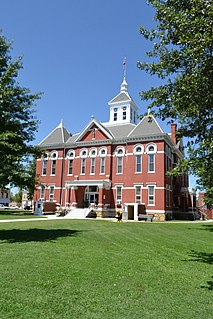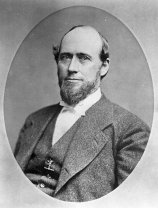Kansas has always been home to many forts and military posts.
In 1862 the citizens of Burlingame, Kansas, constructed a stone fort around the town well, in an intersection in the business district. This was done to prevent the burning of Burlingame by Confederate guerrilla William Anderson, later known as Bloody Bill Anderson. He and his family had lived in a neighboring county up to 1862, but Anderson got into considerable trouble and was forced to leave. Upon leaving, Anderson threatened to burn Burlingame.
Camp Defiance was a military encampment in eastern Kansas, U.S., during 1861–1862. In December 1861, the town of Potosi, Kansas, along the Kansas-Missouri border, was attacked by Confederate guerrillas. Very soon Col. James Montgomery stationed the Kansas 3rd Regiment about 4 miles (6 km) to the northeast.
In the early 1860s Stephen B. Chapman and his family lived on a farm near the town of Black Jack, south of Lawrence, Kansas. In summer 1863 Bushwhackers began traveling through the area, terrorizing the citizens. After William C. Quantrill's Lawrence Massacre on August 21, 1863, the family in September moved west, since the guerrillas passed within sight of their farm.
In spring and possibly through summer 1864, three blockhouses were constructed to help defend the town and post of Fort Scott. These were Fort Blair, Fort Henning and Fort Insley. Fort Blair was enclosed by a rectangular wall of log palisades covered on the outside by earthworks, which in turn were surrounded by a wide, deep ditch. These were to be used by armed men and cannon in case the town and post were attacked by Confederate guerrillas or regular forces. A drawing of Fort Blair and its stockade showed the stockade as about waist high.
In spring and probably into summer 1864 Fort Henning was constructed. It, along with Fort Blair and Fort Insley, was built to help protect the city and post of Fort Scott. Fort Henning, located at the intersection of Second and National Streets, was almost in the center of town. Fort Henning was an octagonal structure and measured fourteen feet across. It was the smallest of the three blockhouse forts.
In spring and summer 1864 Fort Blair, Fort Henning and Fort Insley were constructed to help protect the town and post of Fort Scott from Confederate forces. Fort Insley was named for Capt. Martain H. Insley. It was located just northeast of town, about 1½ blocks northeast of the main part of the post of Fort Scott. It overlooked Buck Run Creek.
Fort Brooks, in northwest Clay County, Kansas, was located three miles west of Clifton, Kansas. Built on the north bank of the Republican River in August or September 1864, it was named for George D. Brooks. Brooks, an ensign in the Shirley County Militia, owned the farm on which the fort was located. Capt. Isaac M. Schooley, the militia commander, was also the fort's commander.
Fort Lincoln was established about August 24, 1861, by United States Senator James Lane. Earlier in August, Lane had reestablished Fort Scott as a military post. Soon Confederate troops under Maj. Gen. Sterling Price threatened to overrun the newly reopened post.
Sometime in 1864 a large log blockhouse was removed from Fort Lincoln, Kansas, and was relocated to the town of Fort Scott, Kansas. This blockhouse was placed at the intersection of Lowman and First streets. Probably a stockade, possibly also removed from Fort Lincoln, was erected around the blockhouse.
Fort Lookout, in the northeast corner of Republic County, Kansas, was established by the US Army near the beginning of the American Civil War, in 1861. Its purpose was to protect the military road running from Fort Riley, Kansas, to Fort Kearney, Nebraska Territory. The area witnessed many attacks by Indians. Fort Lookout was perched on a high bluff overlooking the Republican River. The fort was two miles south of the Kansas-Nebraska border.
Fort Montgomery in the town of Eureka, Kansas was built in summer 1861 by local citizens for protection against Indian attacks and Confederate guerrilla forces.
Fort Simple was an American fort built in Topeka, Kansas, as a result of Maj. Gen. Sterling Price's Missouri Raid in the late summer and fall of 1864. Topeka had become the permanent capital of the State of Kansas in 1861, but no fortifications had been built to protect the city from guerrilla bands, which roamed eastern Kansas. Even the raid and massacre in August 1863 in Lawrence, Kansas, did not result in a fort being built to protect the capital, although plans had been made to build one by July 1864.
In early 1864 settlers in Ottawa County, Kansas, began building Fort Solomon and completed it by the spring or summer. This structure replaced the much smaller dugout owned by the Chapman family and used as a refuge in times of trouble. The Chapman dugout was about a mile south of Fort Solomon. The new white settlers and the Indians in the area quickly developed a hostile relationship and many Indian raids followed.
Iola, Kansas, was founded in 1859 and soon after a two-story stone building was built on the southwest corner of Jefferson and Madison streets. Davis Parsons, one of the first town settlers, built this building, which was to serve as a rallying point and defense headquarters in the event the town was threatened by Bushwhackers or Indians. The area's Indians proved reasonably peaceful and no Bushwhackers threatened the area. The stone building was not truly fortified until the Civil War began.
The Lawrence blockhouses where a series of blockhouses built in the spring of 1864 in Lawrence, Kansas, to provide defensive structures in case of attack by Confederate guerrillas. On August 21, 1863, Lawrence had been attacked by 400 guerrillas and Confederate Army recruits under the command of William C. Quantrill. Lawrence was caught virtually defenseless and much of the town was destroyed and about 180 men and boys were killed, most of them defenseless. A militia became active by spring 1864 to prevent another attack.
Potosi's post, in eastern Linn County, Kansas, was established at the small town of Potosi, Kansas, founded in 1857 by those loyal to the southern cause in Kansas. The other side, the free-staters, soon gained control of the town and it was loyal to the Union when the Civil War broke out in 1861. Potosi was located along the north bank of Mine Creek and it was along the military road running from Fort Leavenworth to Fort Gibson. At its height the town had thirty residents, a store and a post office.
The construction of Fort Plymouth began in summer 1856. The site was settled by a group of free-state partisans who entered Brown County from Nebraska Territory. This site was also meant to become a free-state town, but possibly only one house was constructed on the site. The fort, named after Plymouth Rock by surveyors from Massachusetts, was located on or near the top of a high hill north of Pony Creek. Fort Plymouth was 3 miles (4.8 km) south of the Nebraska border.
Franklin was a small town established in 1854 in Douglas County, Kansas Territory. Established as a proslavery stronghold, the town played a key role in the "Bleeding Kansas" conflict that troubled the territory in the 1850s.


